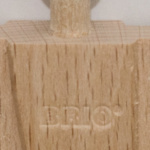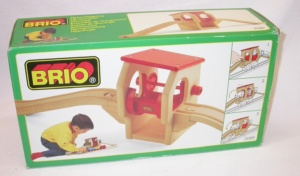eBay is the best place to buy used BRIO Wooden Railway track and accessories at reasonable prices. There is no shortage of merchandise, ranging from vintage sets from the mid 80’s to current products that have had only moderate use. You occasionally will even find products that aren’t for sale in your retail market, as there are sellers who will ship internationally.
Note, however, that I said used BRIO and not new. Unless you are looking specifically for imports, eBay pricing for new items is rarely, if ever, competetive with online retailers such as Amazon, or even your local toy stores by the time you account for shipping charges. I’m of the opinon that you don’t buy new items off of eBay when they can be found locally for about the same price. eBay is a better fit for used and hard-to-find stuff.
The problem with buying off of eBay is that it carries a risk: you are going only off of the seller’s item description and one or more photos that may or may not even show things clearly and in focus. And, with BRIO track, you have an additional risk in that it’s hard to really know if you are getting genuine BRIO parts.
Is it really BRIO?
On eBay, practically everyone says everything is BRIO. The term has become a generic name for wooden trains with plastic wheels, much like Kleenex in the U.S. has become a generic term for facial tissue. There was a time when you could trust that auctions that said “genuine BRIO” meant that the pieces actually were made by BRIO, but even that is not a guarantee anymore. Some people simply do not know what they have, and just call it all BRIO by default.
Your best weapon is to familiarize yourself with the products in old BRIO catalogs, and use those to identify what is and is not a genuine BRIO item. Some items which can be hard to identify, and items which are usually dead giveaways, are listed below.
Track

Track presents the biggest problem because much of the third-party track looks exactly like BRIO track in an eBay-sized photograph. To really tell another brand of track from BRIO, you have to be able to compare the cross sections and the machining of the grooves with a known BRIO piece. Modern BRIO track is often stamped with “BRIO®” just below the male connector, but this is next to impossible to see in photos except on a close-up, and many older track that have been retired pre-date this feature.
Some of the double track pieces (EE, EE1, and K1) and the parallel switches (F1 and G1) have a BRIO sticker on them, which removes all doubt.
The curved switches L and M are distinctively shaped, as are the double-switch versions I and J.
As a general rule of thumb, if all the accessories are BRIO, and all the track parts look like BRIO, then it’s a good guess that it’s BRIO. And of course if you can see the box that the track came in, then it’s all but guaranteed. Still, as with all things eBay, caveat emptor.
Bridges
Bridges are almost always obvious. BRIO bridges come in certain colors, shapes, and lengths, so if you see a blue suspension bridge, for example, you’re not looking at a BRIO part.
Engines and Rolling Stock
These are pretty obvious. Even if you don’t know older BRIO products very well, you can almost always tell by looking at the wheels.
Trees
The shapes of the classic, BRIO trees—there are two—are pretty obvious, but there are non-BRIO trees that are shaped so similarly that they can be hard to differentiate in photos. In person they are recognizable because their thickness and coloration aren’t the same, but it’s not always clear in an eBay listing.
In the 80’s, BRIO also made shorter trees, shrubs, and even two-piece trees. In the mid-2000’s, BRIO started making trees that were wood cut-outs with an actual tree image painted on both sides, instead of the classic, solid green.
People
This one is easy. BRIO has three generations of minifigs: simple wood cutouts from the 80’s, plastic characters with round heads and fixed legs from the 90’s, and the current styling which started in the 2000’s and got some minor tweaking in recent years.
What’s it worth?
This is the million-dollar question. The snarky answer is that it’s worth whatever people are willing to pay.
eBay prices vary wildly, based on condition, scarcity, number of active listings, time of year, number of motivated bidders, overall demand, and a host of factors that can only be described as completely random. There are a few things you should watch out for, however.
Collector Pricing
There are sellers who are obviously trying to appeal to collectors. Sometimes, they really do have something special like #33210, the Harbor Set from the 1980’s, but more often than not they mistake “old” for “valuable” and try to charge accordingly. Visit ToysPeriod.com and see what their collector pricing is. If the eBay Buy It Now or starting bid is close to that, then it had better be MIB. Otherwise, it is way overpriced. Of course in a standard auction you are also going up against other bidders, some of whom might be willing to shell out a lot of money and drive up the sale price.
Vintage? Rare? Valuable?
It seems like every BRIO piece listed on eBay is labeled as “rare”, “hard to find”, “vintage”, or some combination of the three. Obviously if it’s old it’s vintage, but vintage does not mean rare, and just because the seller says it’s rare and HTF, that doesn’t mean that it is. On January, 17th, 2014, for example, there were a dozen listings for complete BRIO Polar Express sets, over half of which still had their original box, and half of those were NIB or factory sealed. Nearly every one of them was listed as “rare” or “extremely rare”. If you can find a dozen of something on eBay at any given time, it’s not rare and by definition it’s not particularly hard to find.

In a similar vein, “rare” and “vintage” do not mean “valuable”. The poster child for this is probably #33389, the Tip Converter. This was one of BRIO’s most bizarre accessories, and hardly anyone bought one because it wasn’t clear what it did: tilt a train car on it’s side, dumping it’s load unceremoniously to the ground. The box illustrations—and yes, it was so alien that BRIO effectively put instructions on the front of the box—implied that it was primarily for use with the plastic tipping wagons. It was (and still is) huge, kind of goofy, and pretty useless. It’s also rare, but I would be hard pressed to call it valuable, except NIB to a collector.
Of course, as time goes on fewer vintage sets show up, so what’s not rare today may be rare tomorrow. Don’t overpay, but be prepared to adjust your opinion.
General Advice
It’s hard to give advice about buying BRIO because often times you are looking for a specific item or items, rather than just wanting to buy up a bunch of track and accessories. But, there are still some general guidelines that can help:
- Don’t ignore lots and starter sets. Sets, in particular, often times bundled items that are unique or hard to find, and can be a tremendous value when you look at everything you are getting. Large sets, however, can be expensive to ship because of their size and weight.
- Ignore track type E, the large curved track, when assessing the size and value of a lot. Every BRIO starter set comes with a bunch of E track, and most lots sold on eBay have more E track than anything else. You will be buried in E track over time assuming you aren’t already. Unless you are just starting out, you do not need or want more of E.
- Only buy track if it’s part of a lot and you are sure it’s BRIO, or if it’s retired track that is no longer sold.
- Know the pricing on items that can still be found in stores. eBay prices can sometimes be more—a lot more— than retail, especially when shipping is factored in.
- Watch the shipping costs, as they can drive the total sale price to unreasonable levels. In the U.S., small items shouldn’t cost more than $6 to $9 to ship via USPS Priority Mail and heavier items shouldn’t ship for much more than $8 to $12 for standard post. People who charge more for shipping are trying to save a few cents on eBay fees, or are using inappropriate shipping methods (such as Priority Mail) for very large and/or heavy items.
- Be vary, vary wary of any descriptions that mention track or pieces having been glued together or to a train table. One something has been glued to a table, particularly with wood glue, they have to be forcibly chiseled up which risks damage to the pieces. Furthermore, the hard glue residue that remains is not coming off without sanding. Gluing wooden track to tables ruins double-sided track permanently. I have managed to save a few specialty pieces that are only machined on one side (straights, triple switches, and so on), and a few buildings, but by and large if it’s been glued it is worthless. And don’t trust listings that say only “a few” pieces of track have been glued: no one glues just “a few” of their children’s track to a table. It is all or none.